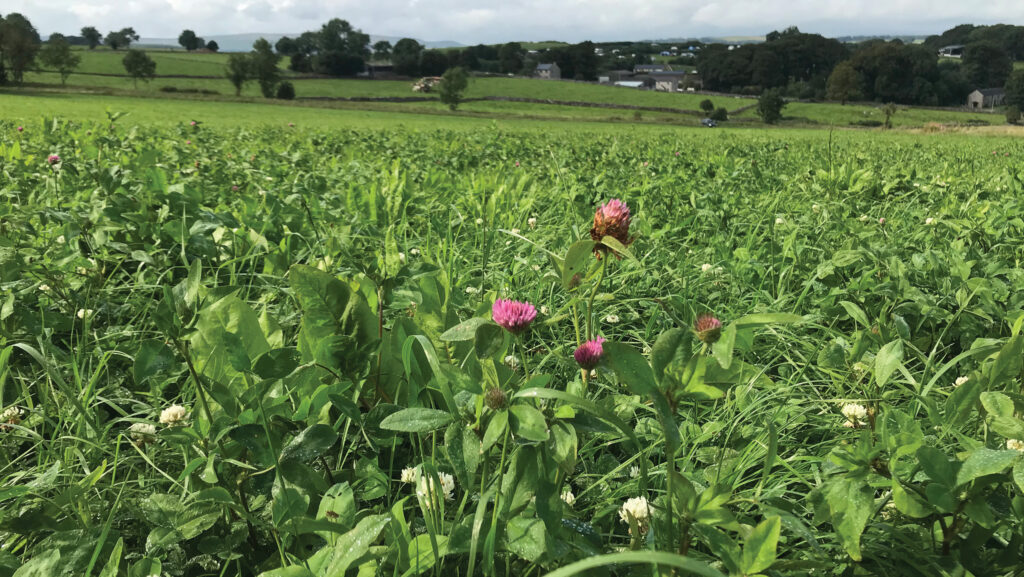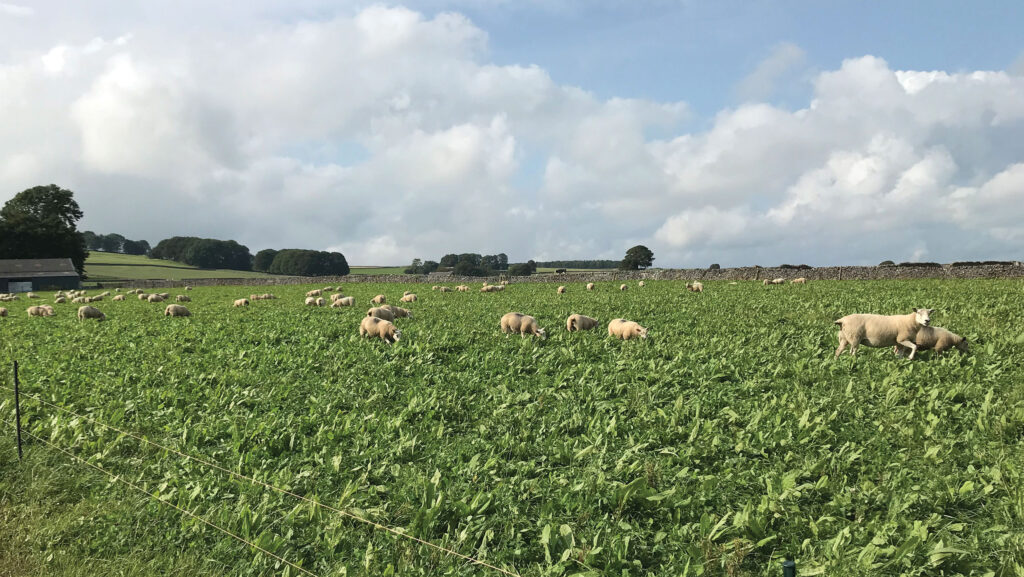Top tips on tailoring herbal leys to upland farms
 © Ben Rodgers
© Ben Rodgers Farmers in upland areas considering herbal leys are encouraged to adopt a step-by-step approach, starting with small-scale trials to determine what works best for their land, before expanding.
This cautious strategy was one of the key messages at a meeting in Penrith, organised by the AHDB, Cumbria Farmer Network and Catchment Sensitive Farming.
See also: Top tips for managing multispecies leys under SFI
Ben Rodgers from Catchment Sensitive Farming stressed the importance of thoughtful planning over rushing to secure Sustainable Farming Incentive (SFI) payments.
“Start small and do it right,” he advised.
“Overcommitting without understanding what suits your farm can lead to disappointment and wasted effort.”

Ben Rodgers © Ben Rodgers
Keys to success with herbal leys
1. Seed mix selection
Consultant James Bretherton of Ag Scope highlighted the need to tailor seed mixes to local conditions.
For Cumbria’s heavy soils, he recommended incorporating grasses such as timothy and herbs like burnet and plantain, or legumes such as white clover.
He also advised farmers to observe which wild species thrive locally, as these can guide seed mix choices.
Ben added that trialling small areas with diverse mixes can reveal what works best.
However, farmers should expect their sward to evolve over time, as some species in the mix may not persist beyond a few years.
2. Establishment techniques
Experts emphasised the importance of achieving good seed-to-soil contact by preparing an optimal seedbed. Key recommendations included:
Soil preparation
Target a pH of 6-6.5, especially if soils are heavy, with adequate phosphorus and potassium levels (index 2+).
Timing
June-July is ideal, thanks to higher soil temperatures (minimum 8-10C required) and sunlight, provided moisture is available.
Drilling technique
While success is possible without glyphosate, this requires shallow drilling (no deeper than 1cm) and strategic grazing post-sowing to reduce competition from the existing sward.
However, Ben noted trials in the Peak District yielded better results following destruction of the previous ryegrass sward and a full reseed. Drilling techniques included overseeding, min-till and direct drilling.
In addition, some farms in the Peaks are also using a lead-in crop such as Westerwold ryegrass to build forage reserves, with up to three silage cuts before establishing herbal leys mid-summer.
Weed management
Weed control should be planned prior to establishment, as herbicide options are limited once herbal leys are growing. Traditional ploughing can bring weed seeds to the surface.
Fertiliser application
Consultant James Hadwin from Mansergh Hall Farm, Cumbria, suggested using up to 20kg of nitrogen (N) during establishment SFI limits nitrogen use to 40kg N/ha).
He cautioned against N use when live grass remains in the ground, instead recommending grazing with ewes to manage competition when direct-drilling herbal leys into grass.
3. Management strategies
Rotational grazing is essential for maintaining herbal leys. James Hadwin employs a radial, leader-follower (cattle and sheep) system for grazing, splitting fields into 1ha (2.5-acre) paddocks.
He has found his most valuable investments to be an ATV-mounted electric fencing wrapper and solar-powered energisers for fencing.
For silage, he recommends avoiding mower conditioners to protect the ley and minimising tedding because of the risk of leaf shatter.

© Ben Rodgers
Farmer insight
Farmer James Hadwin has experience of eight years of growing herbal leys.
More than half of his 66ha (164-acre) farm is now planted with diverse mixes, supporting 250-300 dairy ewes, 200 commercial ewes and up to 80 dairy beef cattle. He also finishes 800 pigs a year.
James has observed no production losses since switching to herbal leys: silage averages 11.2MJ metabolisable energy (ME)/kg dry matter (DM) and 16%-plus protein, while grazed grass achieves 12MJ ME/kg DM and 24%-plus protein (analysed using wet chemistry).

James Hadwin © Sarah Alderton
However, he warned that transitioning animals gradually onto herbal leys is critical to avoid setbacks in production.
“Introduce a herbal ley for a few hours a day and build up. Don’t just graze straight on, as it’s a different protein and energy in the diet.
“After about 10 days, they should be used to it, and you can just leave them on. If you are only growing a small area, it is important to think about how you will integrate it into your system,” he said.
He is trying to graze his dairy flock all year, introducing Highlander and Aberfield genetics to the dairy flock to improve their grazing ability and feet. Texels are used on lower yielders.
James said a combination of breeding for wormer resilience and herbal leys has led to a reduction in wormer use – something that is important in his dairy flock, as no products are licensed for use in lactating animals.
He is now targeting specific herbal ley mixes to individual fields, with all mixes containing grasses that are high on the Recommended List.
“Grasses make up 70% of the sward, so we want to be using the best available,” he said.
James is grazing covers of 3,000kg DM/ha and leaving residuals of 1,200–1,500kg DM.
He says: “The higher cover you go in at, the more persistency you get.”
Funding for herbal leys
SFI funding for farmers in England is available to aid establishment of herbal leys.
CSAM3 (SFI 2024) pays £382/ha for herbal leys established on arable land used to grow crops or lying fallow, temporary grassland, or improved permanent grassland (see here for detailed definition).
To be eligible, a minimum of one grass, two legumes and two herbs is required, and the use of inorganic fertilisers containing nitrogen must be limited to about 40kg N/ha a year.
Farmers at the meeting were advised to keep records of establishment such as invoices from contractors and seed suppliers, along with photos of the established sward.
Peak District herbal ley trial
Upland farms in the Peak District have shown that herbal leys can outperform intensively managed perennial ryegrass (PRG) in small-scale studies led by Catchment Sensitive Farming.
Ben Rodgers explained that farms located on the fertile plateau above the limestone dales, 305m above sea level, with 1,000mm of annual rainfall, found herbal ley yields comparable to PRG receiving more than 200kg of nitrogen.
Farmers were shown the potential to generate more than £500/ha by saving in excess of £150 in nitrogen fertiliser costs and accessing a SAM3 herbal ley payment of £382/ha.
The six initial trial farms, funded to establish leys, have continued to expand their use of herbal leys at their own cost – even before Sustainable Farming Incentive funding became available – because of the observed benefits.
“In the dry summer of 2022, farms saw 50% more crop on herbal leys due to deeper roots – all-important on free-draining limestone,” Ben explained.
He also noted reports from farmers that livestock preferred grazing herbal leys over PRG, with no drop in production.
Many farms now use herbal leys on silage land. At Barkerfields Farm, for example, 65ha (160 acres) of herbal leys yield up to four silage cuts a year.
Ben emphasised that incorporating herbal leys and legume swards delivers both productivity and environmental benefits.
Catchment Sensitive Farming now works with more than 20 farmers in the area to integrate herbal leys into their systems.
